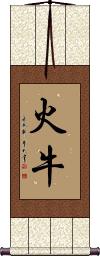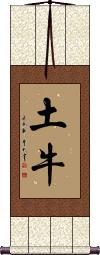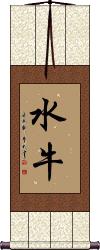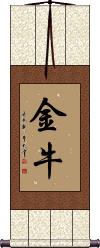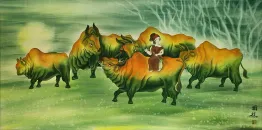Many custom options...
And formats...

Ox Bull in Chinese / Japanese...
Buy an Ox Bull calligraphy wall scroll here!
Personalize your custom “Ox Bull” project by clicking the button next to your favorite “Ox Bull” title below...
Ox / Bull / Cow
Year of the Ox / Bull - Zodiac Sign
牛 is the character for bull, cow, ox, or bovine creature in Chinese, old Korean, and Japanese.
If you were born in the year of the ox/bull/cow, you . . .
Are dedicated to your work.
Are discrete, careful and conscientious.
Value work and family.
Note that in this Chinese character, there is no distinction between bull and cow. All bovine creatures fit into the definition of this character. To distinguish between male and female, another sex-designating character is added in front of this character. Therefore, in China, the energy drink “Red Bull” (Hong Niu) is often translated in the minds of Chinese people as “Red Cow” or even “Red Ox.”
See also our Chinese Zodiac page.
Fire Ox/Bull
The Year of the Fire Ox/Bull
火牛 is Fire Ox/Bull in Chinese.
In the Chinese zodiac and sexagenary (60-year) cycle, this combination occurs in years that include 1877, 1937, 1997, and 2057.
In the sexagenary cycle, this year is represented by 丁丑.
See Also: Ox/Bull
Earth Ox/Bull
The Year of the Earth Ox/Bull
土牛 is Earth Ox/Bull in Chinese.
In the Chinese zodiac and sexagenary (60-year) cycle, this combination occurs in years that include 1889, 1949, 2009, and 2069.
In the sexagenary cycle, this year is represented by 己丑.
See Also: Ox/Bull
Wood Ox/Bull
The Year of the Wood Ox/Bull
木牛 is Wood Ox/Bull in Chinese.
In the Chinese zodiac and sexagenary (60-year) cycle, this combination occurs in years that include 1865, 1925, 1985, and 2045.
In the sexagenary cycle, this year is represented by 乙丑.
See Also: Ox/Bull
Water Ox/Bull
The Year of the Water Ox/Bull
水牛 is Water Ox/Bull in Chinese.
In the Chinese zodiac and sexagenary (60-year) cycle, this combination occurs in years that include 1913, 1973, 2033, and 2093.
In the sexagenary cycle, this year is represented by 癸丑.
See Also: Ox/Bull
Golden/Metal Ox/Bull
The Year of the Golden/Metal Ox/Bull
金牛 is Golden/Metal Ox/Bull in Chinese.
In the Chinese zodiac and sexagenary (60-year) cycle, this combination occurs in years that include 1901, 1961, 2021, and 2081.
In the sexagenary cycle, this year is represented by 辛丑.
See Also: Ox/Bull
Oxford
This in-stock artwork might be what you are looking for, and ships right away...
Gallery Price: $178.00
Your Price: $98.88
Gallery Price: $65.00
Your Price: $35.88
Gallery Price: $178.00
Your Price: $98.88
Gallery Price: $65.00
Your Price: $35.88
Not the results for ox bull that you were looking for?
Below are some entries from our dictionary that may match your ox bull search...
| Characters If shown, 2nd row is Simp. Chinese |
Pronunciation Romanization |
Simple Dictionary Definition |
牛 see styles |
niú niu2 niu nyuu / nyu にゅう |
More info & calligraphy: Ox / Bull / Cow(1) cattle (Bos taurus); cow; bull; ox; calf; (2) {food} (usu. ぎゅう) (See 牛肉) beef; (3) (ぎゅう only) {astron} (See 二十八宿,玄武・げんぶ・2) Chinese "Ox" constellation (one of the 28 mansions); (surname) Nyū go, gaus; ox, bull, bullock, etc. A term applied to the Buddha Gautama as in 牛王 king of bulls, possibly because of the derivation of his name; the phrase 騎牛來牛 (or 騎牛覔牛) to ride an ox, to seek an ox, means to use the Buddha to find the Buddha. |
犍 see styles |
qián qian2 ch`ien chien kon |
used in 犍為|犍为[Qian2 wei4], a country in Sichuan A gelded bull, an ox; a creature half man, half leopard. |
ウシ see styles |
uji ウジ |
(1) cattle (Bos taurus); cow; bull; ox; calf; (2) beef; (personal name) Uzi |
丑牛 see styles |
chǒu niú chou3 niu2 ch`ou niu chou niu |
Year 2, year of the Bull or Ox (e.g. 2009) |
牛年 see styles |
niú nián niu2 nian2 niu nien |
Year of the Ox or Bull (e.g. 2009) |
牛跡 牛迹 see styles |
niú jī niu2 ji1 niu chi goshaku |
Ox-tracks, i. e. the teaching of a Buddha the 牛王 royal bull. |
牡牛 see styles |
mǔ niú mu3 niu2 mu niu oushi / oshi おうし |
bull bull; ox; steer |
雄牛 see styles |
oushi / oshi おうし |
bull; ox; steer |
Variations: |
oushi / oshi おうし |
(See 雌牛) bull; ox; steer |
The following table may be helpful for those studying Chinese or Japanese...
| Title | Characters | Romaji (Romanized Japanese) | Various forms of Romanized Chinese | |
| Ox Bull Cow | 牛 | ushi | niú / niu2 / niu | |
| Fire Ox/Bull | 火牛 | huǒ niú / huo3 niu2 / huo niu / huoniu | ||
| Earth Ox/Bull | 土牛 | tǔ niú / tu3 niu2 / tu niu / tuniu | t`u niu / tuniu / tu niu | |
| Wood Ox/Bull | 木牛 | mù niú / mu4 niu2 / mu niu / muniu | ||
| Water Ox/Bull | 水牛 | shuǐ niú / shui3 niu2 / shui niu / shuiniu | ||
| Golden/Metal Ox/Bull | 金牛 | jīn niú / jin1 niu2 / jin niu / jinniu | chin niu / chinniu | |
| Oxford | 牛津 | niú jīn / niu2 jin1 / niu jin / niujin | niu chin / niuchin | |
Successful Chinese Character and Japanese Kanji calligraphy searches within the last few hours...

